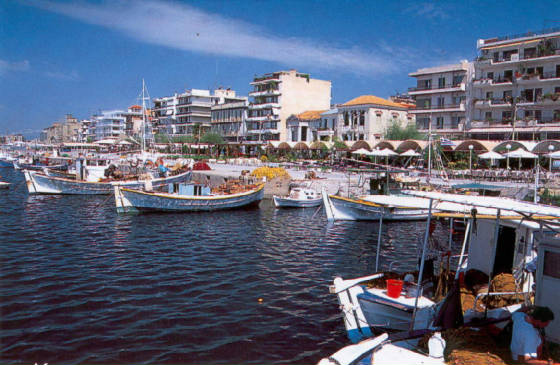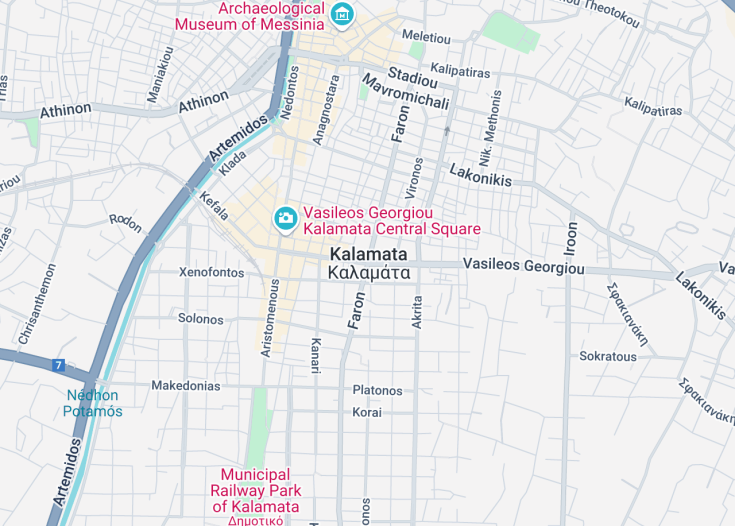Kalamata, the heart of the Messinian Gulf in Greece, is renowned not just for its famous olives but also for its rich history and vibrant cultural scene. This picturesque city offers a unique blend of beautiful landscapes, historical sites, and modern amenities.
Visitors can explore ancient ruins, enjoy bustling marketplaces, and indulge in local cuisine that features fresh, Mediterranean flavors. Kalamata serves as an ideal gateway to the scenic Peloponnese region, promising an authentic Greek experience amidst olive groves and azure coastlines.
When visiting Kalamata, be sure to wander the historic old town. The narrow streets and traditional buildings are a highlight for any traveler.
Plan a visit to the Kalamata Municipal Railway Park for a relaxing and informative afternoon discovering the area’s rail history amidst green surroundings.
Top things to do & see in Kalamata
Select the following sights and activities to discover best tickets and tours available in Kalamata.
Kalamata: A Taste of Authentic Greece
| Country | Greece |
| Time in Kalamata | GMT+2 |
| Language spoken | Greek |
| Population | 54,100 (source: ELSTAT 2021) |
| Currency | Euro (€, EUR) |
| Airports |
|
Nestled in the heart of the Peloponnese peninsula, Kalamata, the capital of the Messinia region, is a city steeped in history and tradition. Known for its sumptuous olives and as a gateway to some of Greece’s most picturesque landscapes, Kalamata offers a unique blend of cultural heritage and modernity. Its origins date back to ancient times, known historically as Pharai, referenced in Homer’s Iliad.
The cityscape features an engaging mix of classical and Byzantine architecture, with the ancient Castle of Kalamata and the 12th-century Church of the Apostles being prominent historic landmarks. These sites not only display the architectural evolution and styles over centuries but also tell tales of Kalamata’s strategic importance through various eras of Greek history.
Rich in cultural heritage, Kalamata comes alive particularly during the summer with the Kalamata Dance Festival, attracting artists and audiences from around the globe. The city’s vibrant arts scene is complemented by its lively markets and festivals, most notably the annual Kalamatiano, celebrating local life, arts, and the famous Kalamata olives.
Economically, Kalamata thrives on agriculture and tourism. Its surrounding fertile lands produce some of the best olives, figs, and citrus fruits in Greece, while its coastline offers expansive beaches and clear waters, ideal for swimming and relaxation. The local cuisine, featuring dishes like the Kalamatianos salad, draws heavily from its agricultural produce, offering a gastronomic experience steeped in local flavors and traditions.
The city also serves as an ideal base for exploring the historical sites of Mystras and the Mani Peninsula, as well as for hiking excursions in the storied Taygetus mountain range. Throughout the year, its mild climate makes it a favorite among locals and tourists alike, offering a blend of natural beauty, historical exploration, and culinary delight.
Where is Kalamata?
Located in southern Greece, Kalamata is positioned at the head of the Messenian Gulf on the Mediterranean coast.
Distances:
| Route | Distance by car | Time by car |
| Athens to Kalamata | 149 miles | 2 hours 30 min |
| Patras to Kalamata | 134 miles | 2 hours 15 min |
| Sparta to Kalamata | 40 miles | 1 hour |
What is Kalamata famous for?
Kalamata is world-renowned for its dark purple olives, a staple of Greek cuisine and a prized export. The city’s rich cultural events, historic architecture, and stunning seafront further enhance its appeal.
History
Prehistoric Period – Ancient Times
The region around Kalamata, situated in the southern part of the Peloponnese, has been inhabited since prehistoric times. Archaeological findings indicate early human presence dating back to the Paleolithic era. During ancient times, the area was known for its participation in the Messenian Wars against Sparta. Following these wars, Kalamata became part of the mighty city-state of Messene, which was founded in 369 BC.
Byzantine Era – 4th to 15th Century
During the Byzantine era, Kalamata flourished as an important religious and economic center. The construction of the Church of the Holy Apostles in the 12th century, which played a significant role in the Greek War of Independence, marks an important architectural addition from this period.
Ottoman Rule – 15th to 19th Century
Kalamata, like much of Greece, fell under Ottoman rule from the 15th century until the 19th century. During this period, the area experienced economic decline and hardship. However, it was also during the Ottoman occupation that Kalamata became known for its silk production.
Modern Period – 19th Century to Present
The modern history of Kalamata begins with its liberation from the Ottomans during the Greek War of Independence in 1821. It was in Kalamata that the first Greek revolutionary flag was raised on March 23, 1821. Since then, the city has undergone significant development, particularly after the catastrophic earthquake of 1986, leading to extensive rebuilding and modernization efforts that have shaped the city as it is known today.
Visit Kalamata
What to see and do in Kalamata
Exploring Kalamata offers a blend of historical sites, vibrant cultural scenes, and natural beauty. Key attractions include the iconic Kalamata Castle, which dates back to the Byzantine era and offers panoramic views of the city and bay.
The city’s old town is a charming area with narrow streets, historic buildings, and bustling cafes. For museum enthusiasts, the Archaeological Museum of Messenia provides insights into the region’s rich history.
- Visit the Church of the Holy Apostles
- Stroll through the Kalamata Municipal Railway Park
- Enjoy the beaches along the Messenian Gulf
- Participate in the Kalamata Dance Festival
Festivals and Events
Kalamata hosts numerous events throughout the year, but the Kalamata Dance Festival in July is particularly noteworthy. This event attracts artists and audiences from around the globe, offering a program filled with dance performances and workshops.
Another significant event is the Kalamatiano Carnival, celebrated with many festivities and traditional dancing during the period leading up to Lent.
Best time to visit Kalamata
The best time to visit Kalamata is during spring (April to June) and early autumn (September to October).
These periods offer pleasant weather, fewer crowds, and the opportunity to participate in local festivals such as the Kalamata Dance Festival and the harvest season for Kalamata olives.
Is Kalamata worth visiting?
Kalamata is undoubtedly worth visiting, not just for its historical significance but also for its vibrant cultural life and natural beauty. From its ancient ruins and Byzantine churches to its scenic beaches and bustling markets, Kalamata offers a rich tapestry of experiences that cater to all interests.
Whether you’re a history buff, a nature lover, or a culture enthusiast, this city provides a unique blend of attractions that promise a memorable stay.









